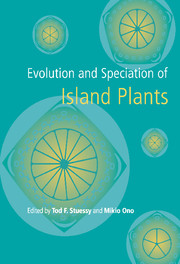Book contents
- Frontmatter
- Contents
- List of contributors
- Preface
- Acknowledgements
- Part one Hawaiian Islands
- Part two Juan Fernandez Islands
- Introduction
- 3 Isolating mechanisms and modes of speciation in endemic angiosperms of the Juan Fernandez Islands
- 4 Dendroseris (Asteraceae: Lactuceae) and Robinsonia (Asteraceae: Senecioneae) on the Juan Fernandez Islands: similarities and differences in biology and phylogeny
- 5 Island biogeography of angiosperms of the Juan Fernandez archipelago
- Part three Southern and western Pacific Islands
- Part four General evolutionary patterns and processes on oceanic islands
- Author index
- Taxon index
- Subject index
3 - Isolating mechanisms and modes of speciation in endemic angiosperms of the Juan Fernandez Islands
Published online by Cambridge University Press: 04 May 2010
- Frontmatter
- Contents
- List of contributors
- Preface
- Acknowledgements
- Part one Hawaiian Islands
- Part two Juan Fernandez Islands
- Introduction
- 3 Isolating mechanisms and modes of speciation in endemic angiosperms of the Juan Fernandez Islands
- 4 Dendroseris (Asteraceae: Lactuceae) and Robinsonia (Asteraceae: Senecioneae) on the Juan Fernandez Islands: similarities and differences in biology and phylogeny
- 5 Island biogeography of angiosperms of the Juan Fernandez archipelago
- Part three Southern and western Pacific Islands
- Part four General evolutionary patterns and processes on oceanic islands
- Author index
- Taxon index
- Subject index
Summary
Abstract
The Juan Fernandez Islands are located 667 km west of continental Chile at 33° S latitude. They contain 104 endemic angiosperms. Although numerous isolating mechanisms and modes of speciation are known for plants of continental regions, few have been documented for those on Juan Fernandez. A survey of endemic angiosperms reveals spatial isolation (between islands) within the archipelago as the most important primary factor accounting for 70% of closely related species pairs. Environmental (habitat) isolation occurs within individual islands and is known in 18% of cases. External reproductive isolation is less common, with temporal isolation accounting for 7% of cases, mechanical isolation only 3% and autogamy known in only two situations (3%). There is no indication of internal reproductive isolation between close congeners, although direct experimental evidence is lacking. Almost no changes in chromosome number or reticulation during speciation are known. Isozyme and DNA comparisons show low levels of genetic divergence among endemic congeners, yet conspicuous morphological differences often exist. The eroded environment of the older island, Masatierra, gives fewer clues to geological and ecological components of speciation. The younger island, Masafuera, has stronger ecological zonation and species of some genera (e.g., Erigeron) correlate with particular environments. The overall pattern of speciation in the archipelago, therefore, is divergence at the diploid level, initiated by geographic isolation especially between islands, accelerated by ecological partitioning within islands, accompanied by marked morphological change in response to changing environments, but with relatively minor genetic modification.
- Type
- Chapter
- Information
- Evolution and Speciation of Island Plants , pp. 79 - 96Publisher: Cambridge University PressPrint publication year: 1998
- 14
- Cited by

